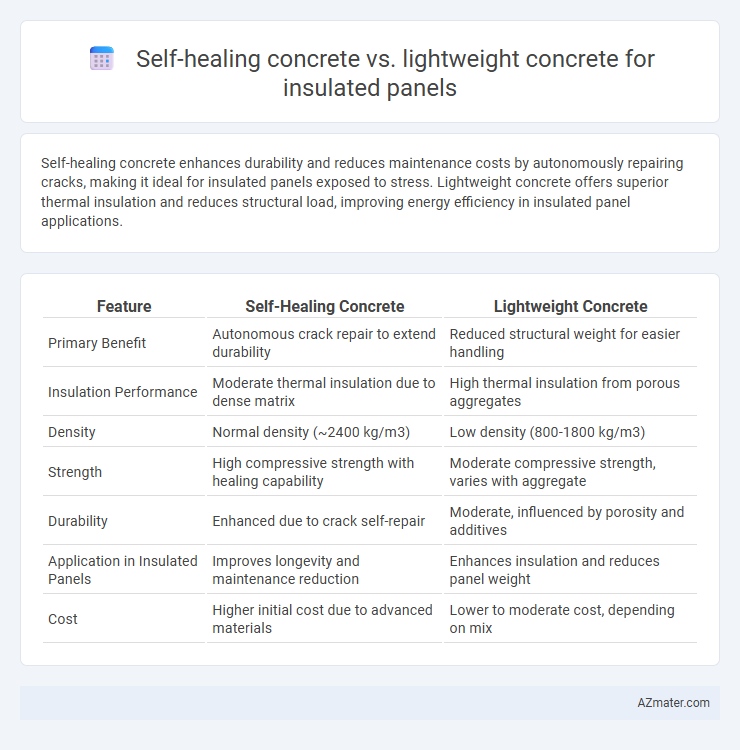Self-healing concrete enhances durability and reduces maintenance costs by autonomously repairing cracks, making it ideal for insulated panels exposed to stress. Lightweight concrete offers superior thermal insulation and reduces structural load, improving energy efficiency in insulated panel applications.
Table of Comparison
| Feature | Self-Healing Concrete | Lightweight Concrete |
|---|---|---|
| Primary Benefit | Autonomous crack repair to extend durability | Reduced structural weight for easier handling |
| Insulation Performance | Moderate thermal insulation due to dense matrix | High thermal insulation from porous aggregates |
| Density | Normal density (~2400 kg/m3) | Low density (800-1800 kg/m3) |
| Strength | High compressive strength with healing capability | Moderate compressive strength, varies with aggregate |
| Durability | Enhanced due to crack self-repair | Moderate, influenced by porosity and additives |
| Application in Insulated Panels | Improves longevity and maintenance reduction | Enhances insulation and reduces panel weight |
| Cost | Higher initial cost due to advanced materials | Lower to moderate cost, depending on mix |
Introduction to Innovative Concrete Solutions
Self-healing concrete integrates microcapsules or bacteria that autonomously repair cracks, enhancing the longevity and durability of insulated panels. Lightweight concrete offers superior thermal insulation due to its reduced density and porous structure, making it ideal for energy-efficient building envelopes. Combining these innovative solutions revolutionizes insulated panel performance by improving structural integrity and thermal efficiency simultaneously.
Self-Healing Concrete: Definition and Mechanism
Self-healing concrete is an innovative material designed to autonomously repair cracks through embedded agents such as bacteria or microcapsules that activate upon damage, enhancing durability and longevity. Its mechanism involves the precipitation of calcium carbonate or polymerization within the crack, effectively sealing it and preventing moisture ingress and structural degradation. This process significantly reduces maintenance costs and extends the lifespan of insulated panels compared to lightweight concrete, which primarily focuses on thermal insulation but lacks intrinsic repair capabilities.
Lightweight Concrete: Composition and Benefits
Lightweight concrete used in insulated panels typically comprises expanded aggregates such as expanded clay, shale, or pumice combined with cement and water, reducing density while maintaining strength. This composition enhances thermal insulation, fire resistance, and reduces structural load, making it ideal for energy-efficient building envelopes. Its lower thermal conductivity and improved acoustic performance contribute significantly to sustainable construction practices.
Thermal Insulation in Modern Panel Systems
Self-healing concrete enhances thermal insulation in modern panel systems by reducing microcracks, which minimizes heat transfer and improves energy efficiency. Lightweight concrete offers inherent thermal insulation properties due to its porous structure, lowering thermal conductivity and providing better temperature regulation. Both materials contribute to advanced insulated panels, with self-healing concrete focusing on durability and crack resistance while lightweight concrete prioritizes thermal performance and structural weight reduction.
Durability: Self-Healing vs Lightweight Concrete
Self-healing concrete enhances durability in insulated panels by autonomously repairing microcracks, reducing maintenance costs and extending service life. Lightweight concrete offers moderate durability benefits by reducing dead loads and improving thermal insulation but remains vulnerable to crack propagation without self-repair mechanisms. Integrating self-healing properties significantly surpasses traditional lightweight concrete in maintaining structural integrity under environmental stress.
Structural Performance Comparison
Self-healing concrete enhances structural durability by autonomously repairing micro-cracks, significantly reducing maintenance costs and extending the lifespan of insulated panels. Lightweight concrete offers improved thermal insulation and decreased dead load, yet its lower compressive strength and brittleness can compromise structural integrity under heavy loads. Comparing the two, self-healing concrete provides superior crack resistance and longevity, while lightweight concrete prioritizes weight reduction and insulation, making the choice dependent on specific structural performance and thermal requirements.
Environmental Impact and Sustainability
Self-healing concrete reduces environmental impact by extending the lifespan of insulated panels through autonomous crack repair, minimizing the need for repairs and material replacement. Lightweight concrete enhances sustainability by lowering structural weight, reducing transportation emissions, and improving thermal insulation, which decreases energy consumption in buildings. Both materials contribute to eco-friendly construction but target sustainability through durability and energy efficiency, respectively.
Cost Considerations for Insulated Panels
Self-healing concrete offers long-term cost savings by reducing maintenance and repair expenses in insulated panels, though its initial production costs are higher compared to lightweight concrete. Lightweight concrete provides immediate cost efficiency due to lower material and handling costs but may incur additional expenses over time for repairs and insulation performance. Evaluating the total lifecycle cost, including durability and thermal insulation properties, is crucial when selecting between self-healing and lightweight concrete for insulated panel applications.
Installation and Maintenance Differences
Self-healing concrete in insulated panels reduces maintenance by automatically sealing cracks, minimizing long-term repair costs and improving durability during installation without the need for frequent inspections. Lightweight concrete panels offer faster installation due to their reduced weight, lowering labor costs but often require more regular maintenance to address potential surface damage or thermal performance degradation. Choosing between the two depends on project priorities: self-healing concrete emphasizes longevity and lower maintenance, while lightweight concrete focuses on ease of handling and installation speed.
Choosing the Right Concrete for Insulated Panels
Self-healing concrete enhances durability and longevity in insulated panels by autonomously repairing cracks, reducing maintenance and improving thermal efficiency over time. Lightweight concrete offers superior insulation due to its reduced density and enhanced thermal resistance, making it ideal for energy-efficient panel construction. Selecting the right concrete depends on prioritizing self-repair capabilities for long-term performance or optimizing thermal insulation with lightweight materials in insulated panel applications.

Infographic: Self-healing concrete vs Lightweight concrete for Insulated panel
 azmater.com
azmater.com